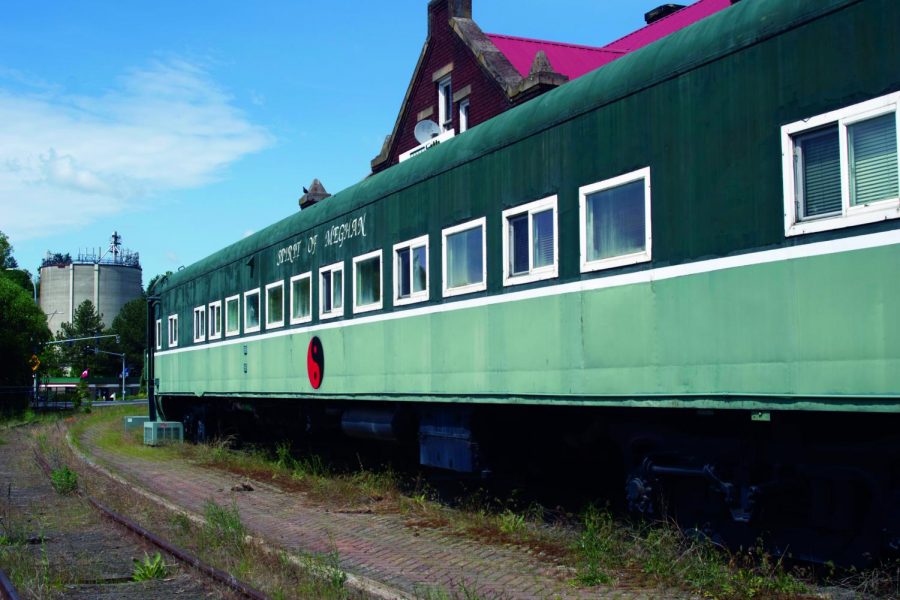Historical Society aims to restore Pullman depot
Two rail cars will be removed from property due to health hazard
May 23, 2018
Foggy windows surrounded by cracking window frames, peeling wallpaper, cobwebs coated in a layer of dust and a glossy red parking meter. All distinct features within the Pufferbelly Depot sitting on the edge of the South Fork of the Palouse River in the heart of downtown Pullman.
Now the brick building that hasn’t seen a passenger train leave its station since 1970 will get a restoration from the Whitman County Historical Society.
Kathy Meyers, co-chair of the WCHS steering committee, said the railroad is an integral part of the history of the community.
“The railroads caused a big growth in the town and they were one of the main reasons that the state chose Pullman for [WSU],” Meyers said.
A $300,000 loan from an anonymous donor helped WCHS buy the property in early March after it was put up for sale a month before by Meghan Antoni in an attempt to return the depot to its original form.
Meghan is the daughter of the previous owner, Dan Antoni, who passed away in 2015.
Antoni was forced to put the depot on the market after her father’s estate had accumulated a large amount of debt, and said before her father passed away he asked her not to sell the depot.
“It broke my heart to sell it,” Antoni said. “That depot was my dad’s life, his legacy and it was his pride and joy. He absolutely loved that depot.”
The depot was originally built in 1887 and was made entirely of wood until it received a makeover in 1917 that gave the building its current brick exterior.
The old railroad station has gone through several name changes throughout the years, including being called the Northern Pacific Train Depot. When Dan bought the depot in 1988 he renamed it Pufferbelly in honor of steam locomotives, Antoni said.
Dan ran two businesses out of the depot for 27 years; a real estate agency and a vehicle licensing office. Antoni worked part time at the depot while attending WSU from 2010-2014 and helped her father with the licensing business. She kept track of the books and ran deposits back and forth to the bank.
“It was his vision that when he passed away that I would take on his licensing business and I would succeed him,” Antoni said.
Although Antoni was unable to fulfill this wish and keep the depot, she said her father would be happy with her decision to sell the depot to WCHS in order to restore it.
Besides growing the town and bringing a university to Pullman, Meyers said the depot increased agriculture in the area as soon as it was built by providing cheap, easy and fast transportation to move goods.
“Before the railroads came,” Meyers said, “the only way to get your crops to market was on the river.”
The train also provided a source of transportation for WSU students to get to towns like Spokane and Lewiston before cars started to take over in the late 1960s and ultimately halted the station’s business.
Meyers came to Pullman in 1970 to attend WSU and recalls the echoes the locomotives used to send through the town.
“When we moved here you could hear train whistles two, three times a day,” Meyers said. “They ran so punctually that people use to joke that you could set your watches to the train whistle.”
The depot is the central point where the main threads of the history of Pullman, WSU and agriculture come together, Meyers said, and they hope to highlight that with the restoration.
Meyers said the goal is to keep as many as the historical features of the depot as possible and create an interpretive center with hands on and interactive activities for all ages.
“I think it’s important to know your history,” Meyers said, “so you can figure out who you are and where you came from.”
There are several cosmetic things the WCHS will need to replace, Meyers said, including the doors, windows and light fixtures.
They will also need to remove two train cars in front of the building because of a health hazard, Meyers said. Runoff from the roof of the building on to the railcars due to rain has caused water damage and resulted in black mold.
Meyer said they will either have to bring in a crane to remove the train cars that are mounted to the railroad tracks or piece them out for salvage. Taking away the rail cars would allow the front of the building to be more visible to the community.
WCHS is in the early stages of figuring out their long-term plans for the depot and there is no timetable for its completion yet, but Meyers wants to create a gathering place for people in the community and has an idea of what the historic building will look like in the future.
“I can picture it,” Meyers said, “but I can’t draw it because I’m not an artist.”










